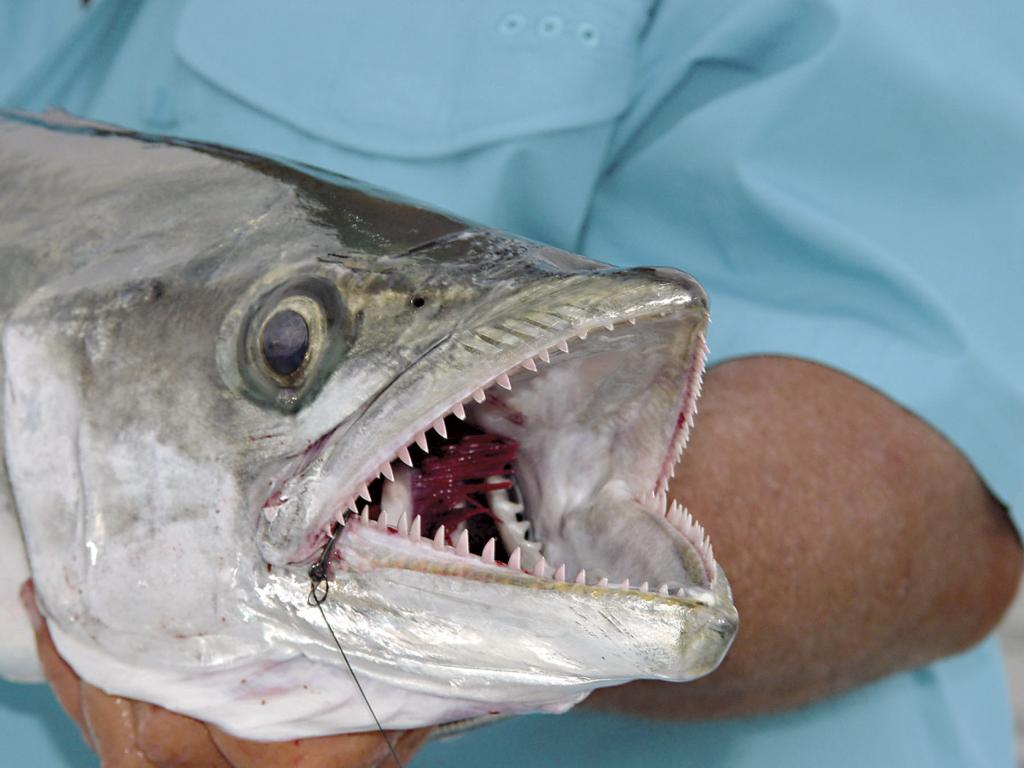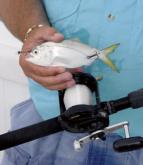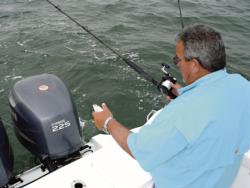Pogies
The bait a kingfish can’t refuse

Trolling an area near jetties along the western coast of Texas, guide Bruce Shuler pointed to a cloud of baitfish dimpling the surface of the water. Pogies, literally thousands of them in a school the size of a swimming pool, were writhing on the surface, providing a calling card for any predators in the area.
“Look at that, all of those baitfish on top of the water,” Shuler said. “Get ready. In a minute, you’ll start seeing kings busting those fish.”
How right he was. In just seconds, the baitfish were being cut to shreds, the victims of a school of kingfish moving through the area. The kings savaged the pogies from all sides, with several large fish going aerial in their pursuit of a meal. If ever there was fish that wouldn’t turn down an easy meal, that creature is definitely the king mackerel, a pelagic bruiser known all across the gulf for its fierce fight.
An easy meal
 If there is a meal that no king, not even the most fickle, could turn down, then that is menhaden, known most commonly as pogies, but also called bunkers, fatbacks, bugfish and LY (phonetic for alewives). Widely distributed throughout the Atlantic, anglers from Florida to Texas are very familiar and quite fond of the pogy, largely because no self-respecting predator can pass one up.
If there is a meal that no king, not even the most fickle, could turn down, then that is menhaden, known most commonly as pogies, but also called bunkers, fatbacks, bugfish and LY (phonetic for alewives). Widely distributed throughout the Atlantic, anglers from Florida to Texas are very familiar and quite fond of the pogy, largely because no self-respecting predator can pass one up.
Plankton eaters, pogies can frequently be seen in the summer months near the surface as they feed on zooplankton and phytoplankton. Because of their large numbers, rapid growth rate and pelagic nature, they are favorites of fish including tuna, striped bass, bluefish and sharks. Birds, too, such as herons and gulls, find them irresistible. But it’s unlikely that any fish takes more delight in seeing thousands of pogies on the surface than the toothy kingfish, one of nature’s stealthiest killers.
“King mackerel just absolutely love pogies,” said Captain Alex Crawford, a guide from Apalachicola, Fla. “It’s the finest bait you can have in your livewell, if you’re after kingfish.”
The bait of choice
Crawford, who chases kings, along with a host of other game-fish species, along the Gulf of Mexico, said when kings begin to move north as the water warms in late spring, these large pods of pogies, found throughout the coast, become the bait of opportunity. While kings are likely after cigar minnows, the plentiful pogies are hard to turn down. “If they can find bait like a school of pogies, they are going after them,” he said. “They are going to cut them up.”
Aside from being so plentiful, another, maybe even more important, reason pogies are so desirable to kingfish, and thus kingfish anglers, is that they are very oily fish, making it easy for predators to seek them out. The oil from a pod of pogies will often cover the surface as they feed. And when they are  being thrashed about by kings, not only blood but also the oily residue from their bodies coats the surface of the water, a fact that often invites even more predators to the area.
being thrashed about by kings, not only blood but also the oily residue from their bodies coats the surface of the water, a fact that often invites even more predators to the area.
Catching pogies
It comes as no surprise that many anglers fishing the Wal-Mart FLW Kingfish Tour look to put pogies in their livewells come tournament time. And to do so, they typically don’t have much of a problem. In the early morning hours, often just before sunlight, pogies will often feed on plankton right at the surface, in plain sight of anglers. “If you can visualize raindrops on the water, that’s what it looks like,” Crawford said. “Pogies are famous for feeding on the surface right at first light.”
What Crawford prefers to do to catch these fish is allow his boat to drift in close to the school, then he throws a cast net. In one cast an angler can get 15 to 20 dozen or more, he said. Once caught, he places the fish in a large, cylindrical bait tank with a powerful aeration pump, a requirement for keeping the fish alive for any span. The round tank ensures that the fish can swim in circles and not bump the sides, which is necessary for their survival, and the vigorous pump keeps a large dose of oxygen entering their gills.
Fishing with pogies
Because kings are open-water fish prone to continuous motion while seeking out a meal, anglers look for areas where the fish are actively seeking a feeding opportunity. Some of the best areas are those places that feature a live coral bottom. These areas, popular locations for any predator looking for an easy meal, are typically alive with activity from a host of baitfish species.
Using a 135-pound stainless-steel wire as a leader, an angler fishes a whole pogy with a four-times-strong treble hook placed through the bait’s nostrils and another placed either through its dorsal fin or allowed to dangle behind the bait. Fishermen then either anchor in one spot or slowly troll, with several baits at different levels in the water column. Should the angler get a hit, a marker buoy is thrown over or the GPS waypoints are entered to allow them to find and fish that same location thoroughly.
“Since those fish are schooled up, you’re likely to catch another one,” Crawford said. “He wasn’t there by himself.”
Most of the fish caught in late spring and early summer are what many anglers call snakes, fish in the 7- or 8-pound range. But there is also a legitimate chance of catching a smoker as well. The name is derived from how they are prepared, but also refers to what the king mackerel can do to a reel when they make a run. The reels will often be left smoking from the tension of the fish stripping line – and drag, too – rapidly from the reel.
If the water temperature has been steadily increasing, as it normally does this time of year, there’s a high degree of certainty that pogies are showing up all along the Gulf of Mexico. The kings, too, are likely there in droves. Anglers need only find pods of bait on the surface or look for an area with a live corral bottom to have success. Chances are, at least one reel will be smokin’ before the day is over.
Anglers who run into a school of aggressive kings but have no live pogies on hand should fish the next best thing: artificials. Though the live offerings are preferred, kings love large pogy-immitating soft plastics, topwater lures and spoons. If fish are seen working shad in the area, start out fishing on top with a Berkley Saltwater Frenzy or Saltwater Popper. If there are no takers up top, though, go with a Mann’s Loudmouth spoon or soft plastics such as the Mann’s Mannhaden or Berkley’s Power Bait Saltwater Pogy. Either of these offerings is sure to get some attention.

